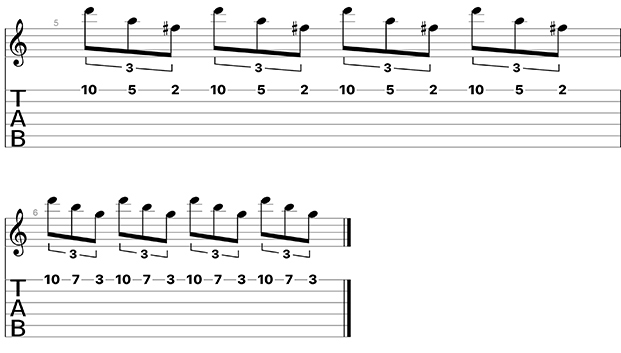Randy Rhoads-Style Melodic Tapping Exercise Using Common Tones
Not only will this exercise get your fingers moving, but it will get your brain moving too.

Today I'd like to show you a cool melodic tapping excercise in the style of the late, great Randy Rhoads.
Not only will this exercise get your fingers moving, but it will get your brain moving too.
As you already know from my previous lessons, it's super important for guitar students to not only practice and play well but to know what they're playing.
So before we get to the tapping part of this excercise, let's discuss the chord progression behind it—which is actually the purpose of the lesson.
When switching from chord to chord on any instrument, to make the transitions smooth and seamless, sometimes we use what is known as common tones. Common tones are tones—or notes—that are common between the chord changes we're playing. For example, in this excercise we are in the key of G major. The first measure spells out a G major triad in which we find the notes G, B and D.
The first note of every triplet is the note that is tapped. The second measure spells out an E minor chord. The notes in an E minor chord are E, G and B. For the tapping sequence to be smoother, we look for the common tones between the G major and E minor chords. As you can see, there are two common tones, the G and the B.
So what we do is keep the G at the third fret of the first string and the B at the seventh fret of the first string, and in the second measure we move from tapping on the 10th fret of the first string, which is a D, to tapping on the 12th fret of the first string, which is an E. There you go; a seamless move from G major to E minor with very little hand- and right-hand movement.
All the latest guitar news, interviews, lessons, reviews, deals and more, direct to your inbox!
The third measure is a C major chord in which the notes are C, E and G. What are the common tones between C major and E minor in the previous measure? The common tones are the E and the G. So we keep tapping on the 12th fret of the first string, which is E, and keep the G on the third fret and move the pinky of the left hand to the C on the eighth fret of the first string.
A word of caution: The left-hand stretch from the third fret to the eighth fret is kind of rough, so make sure your left hand is relaxed. If you feel discomfort, stop. The fourth measure is an A minor chord in which the notes are A, C and E. What are the common notes between A minor and the C major in the previous measure? There are two common tones, and they are the C and the E. So we continue tapping on the 12th fret of the first string, which is the E, keep the eighth fret note, which is the C, and move our first finger to the fifth fret of the first string, which is the A.
The fifth measure of this excercise is a D major chord in which the notes are D, F# and A. What are the common tones between the D major chord and the A minor chord in the previous measure? Well, there are none, so we have to move our left and right hand positions to tap the D on the 10th fret of the first string and finger the F# on the second fret of the first string and the A on the fifth fret of the first string.
Finally we are at the sixth and final measure of the excercise, which is back to the tonic chord, G major. What are the common tones between the G major chord and the D major chord in the previous measure? The only common tone is the D, so we keep tapping the D on the 10th fret of the first string and move our left hand to its original position of the G on the third fret of the first string and the B on the seventh fret of the first string.
This chord progression, which we are outlining with tapping, should sound familiar to you. It's a I, VI, IV, II, V, I in the key of G major. Just for fun, try and set up a looper and play the background chords while doing the tapping and see what it sounds like—or have a friend play the chord progression while you're tapping. It's OK. You can take turns so no one is "stuck" playing rhythm. Only guitarists will get that inside joke.
How many more common tone excercises for chords and arpeggios can you come up with? Hundreds, probably!
- Any comments and suggestions are always welcome and encouraged. Now get off the computer, pick up that guitar and play!

Richard Rossicone is a veteran of the NYC/Long Island original/cover band scene. He's been playing since he was 8, when he attended his first concert (Kiss) and saw Pete Townshend smash a guitar. He has studied with various instructors over the years, which led him to a career in music therapy. He began his educational journey at Queensboro Community College, where the faculty introducing him to classical music. He received his associate's degree in fine arts in 1997 and went on to receive his bachelor's in music therapy in 2001 and his master's in music therapy from New York University in 2004. Richard continued his studies at C.W. Post University, pursuing a second master's degree in classical guitar performance and music history, studying under Harris Becker. He's been teaching guitar, piano and theory since 2002 and in 2006 started his own company, Rossicone Music Studios. Visit him at Axgrinder.com and his Complete Guitarist Facebook page.
